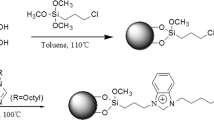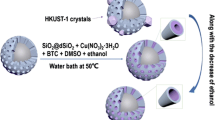Abstract
Ethyl-bridged organic–inorganic hybrid silica particles were prepared via a sol–gel and hydrothermal synthesis approach using 1,2-bis(triethoxysilyl)ethane (BTESE) as the sole precursor, and triblock copolymer poly(ethylene oxide)-block-poly(propylene oxide)-block-poly(ethylene oxide) (P123) and dodecyltrimethylammonium bromide (DTAB) as combined templates. The morphology, pore structure, chemical composition and liquid chromatographic performance of the obtained materials were investigated in detail. The particles exhibit a high surface area of 1136.40 m2/g, together with a pore volume of 0.39 cm3/g and an average pore size of 2.30 nm. Used as stationary phase for high-performance liquid chromatography (HPLC), the particles without extra bonding either C18 or C8 can successfully separate a mixture of uracil, phenol, pyridine, methylbenzene, ethylbenzene and tert-butylbenzene. The obtained materials also show practical application in the separation of phthalate acid esters (PAEs), which are harmful to environment and human health. Although the columns packed with ethyl-bridged organic–inorganic hybrid silica show lower column efficiency and peak symmetry compared to commercial column, they have considerably higher chemical stability in alkaline mobile phase. The HSS column also possesses high mechanical stability which is similar to that of the commercial column.











Similar content being viewed by others
References
Nawrocki J, Dunlap C, Mccormick A (2004) Part I, Chromatography using ultra-stable metal oxide-based stationary phases for HPLC. J Chromatogr A 1028:1–30
Poole CF, Kiridena W, Dekay C (2006) Insights into the retention mechanism on an octadecylsiloxane-bonded silica stationary phase (HyPURITY C18) in reversed-phase liquid chromatography. J Chromatogr A 1115:133–141
Zhang Y, ** Y, Yu H (2010) Pore expansion of highly monodisperse phenylene-bridged organosilica spheres for chromatographic application. Talanta 81:824–830
Mccalley DV (1999) Comparison of the performance of conventional C18 phases with others of alternative functionality for the analysis of basic compounds by reversed-phase high-performance liquid chromatography. J Chromatogr A 844:23–38
Kirkland JJ, Glajch JL, Farlee RD (1989) Synthesis and characterization of highly stable bonded phases for HPLC column packings. Anal Chem 61:2–11
Floyd TR, Hartwick RA, Dibussolo JM (1988) Studies on the stabilization of reversed phases for liquid chromatography. J Chromatogr A 443:155–172
Kirkland JJ, Henderson JW, Destefano JJ (1997) Stability of silica-based, endcapped columns with pH 7 and 11 mobile phases for reversed-phase high-performance liquid chromatography. J Chromatogr A 762:97–112
Kirkland JJ, van Straten MA (1995) High pH mobile phase effects on silica-based reversed-phase high-performance liquid chromatographic columns. J Chromatogr A 691:3–19
Mandal M, Manchanda AS, Zhuang J (2012) Face-centered-cubic large-pore periodic mesoporous organosilicas with unsaturated and aromatic bridging groups. Langmuir 28:8737–8745
Nohair B, Thao PTH, Nguyen VTH (2012) Hybrid periodic mesoporous organosilicas (PMO-SBA-16): a support for immobilization of d-amino acid oxidase and glutaryl-7-amino cephalosporanic acid acylase enzymes. J Phys Chem C 116:10904–10912
Wang W, Grozea D, Kohli S (2011) Water repellent periodic mesoporous organosilicas. ACS Nano 5:1267–1275
Mandal M, Kruk M (2010) Large-pore ethylene-bridged periodic mesoporous organosilicas with face-centered cubic structure. J Phys Chem C 114:20091–20099
Castricum HL, Sah A, Kreiter R (2008) Hydrothermally stable molecular separation membranes from organically linked silica. J Mater Chem 18:2150–2158
Claessens HA, van Straten MA (2004) Review on the chemical and thermal stability of stationary phases for reversed-phase liquid chromatography. J Chromatogr A 1060:23–41
Yoshina-Ishii C, Asefa T (1999) Periodic mesoporous organosilicas, PMOs: fusion of organic and inorganic chemistry ‘inside’ the channel walls of hexagonal mesoporous silica. Chem Commun 24:2539–2540
Huang L, Lu J, Di B (2011) Self-assembled highly ordered ethane-bridged periodic mesoporous organosilica and its application in HPLC. J Sep Sci 34:2523–2527
Neue UD, Walter TH, Alden BA (1999) Use of high-performance LC packings from ph1 to ph 12. Am Lab 31:36–39
Liu Y, Grinberg N, Thompson KC (2005) Evaluation of a C18 hybrid stationary phase using high-temperature chromatography. Anal Chim Acta 554:144–151
Wei Q, Wang F, Nie ZR (2008) Highly hydrothermally stable microporous silica membranes for hydrogen separation. J Phys Chem B 112:9354–9359
Mesa M, Sierra L, López B (2003) Preparation of micron-sized spherical particles of mesoporous silica from a triblock copolymer surfactant, usable as a stationary phase for liquid chromatography. Solid State Sci 5:1303–1308
Shu L, Chen S, Zhao WW (2016) High-performance liquid chromatography separation of phthalate acid esters with mil-53(al) packed column. J Sep Sci 39:3163–3170
Jiang DD, Wei Q, Cui SP (2006) Controllable morphology and pore structure of micron-sized organic–inorganic hybrid silica spheres derived from silsesquioxane. J Sol Gel Sci Technol 78:40–49
Wyndham KD, O’Gara JE, Walter TH (2003) Characterization and evaluation of C18 HPLC stationary phases based on ethyl-bridged hybrid organic/inorganic particles. Anal Chem 75:6781–6788
Yu H, Jia C, Wu H (2012) Highly stable high performance liquid chromatography stationary phase based on direct chemical modification of organic bridges in hybrid silica. J Chromatogr A 1247:63–70
Chen WY, Wei Q, Liu YJ (2014) The particle size control of organic–inorganic hybrid silica by surfactant-mediated assembly of silsesquioxane. Adv Mater Res 1058:30–34
Lu J, Huang L, Di B (2011) Spherical periodic mesoporous organosilicas bearing camphorsulfonamide substructures for HPLC. Chromatographia 74:515–521
Cai H, Zhao D (2009) A mild method to remove organic templates in periodic mesoporous organosilicas by the oxidation of perchlorates. Micropor Mesopor Mater 118:513–517
Yue XY, Jiang DD, Shu L (2016) Mesoporous C18-bonded ethyl-bridged organic–inorganic hybrid silica: a facile one-pot synthesis and liquid chromatographic performance. Micropor Mesopor Mater 236:277–283
Canivet J, Fateeva A (2014) Water adsorption in MOFs: fundamentals and applications. Chem Soc Rev 43:5594–5617
Canivet J, Bonnefoy J, Daniel C (2014) Structure–property relationships of water adsorption in metal-organic frameworks. N J Chem 38:3102–3111
Khutia A, Rammelberg HU, Schmidt T (2013) Water sorption cycle measurements on functionalized mil-101Cr for heat transformation application. Chem Mater 25:790–798
Schoenecker PM, Carson CG, Jasuja H (2012) Effect of water adsorption on retention of structure and surface area of metal–organic frameworks. Ind Eng Chem Res 51:6513–6519
Liu J, Wang Y, Benin AI (2010) CO2/H2O adsorption equilibrium and rates on metal–organic frameworks: HKUST-1 and Ni/DOBDC. Langmuir 26:14301–14307
Na W, Wei Q, Lan JN (2010) Effective immobilization of enzyme in glycidoxypropyl-functionalized periodic mesoporous organosilicas (PMOs). Micropor Mesopor Mater 134:72–78
Jang HR, Oh HJ, Kim JH (2013) Synthesis of mesoporous spherical silica via spray pyrolysis: pore size control and evaluation of performance in paclitaxel pre-purification. Micropor Mesopor Mater 165:219–227
Borges EM, Volmer DA (2015) Silica, hybrid silica, hydride silica and non-silica stationary phases for liquid chromatography. Part II: chemical and thermal stability. J Chromatogr Sci 53:1107–1122
Acknowledgements
This research was financially supported by Scientific Research Common Program of the Bei**g Municipal Commission of Education (Grant No. KZ201410005006), National Natural Science Foundation of China (Grant Nos. 21171014, 50502002, 51402007), Bei**g Natural Science Foundation of China (Grant No. 2141001), State Key Laboratory of Solid Waste Reuse for Building Materials (Grant No. SWR-2014-010), and Funding Project for Academic Human Resources Development in Institutions of Higher Learning Under the Jurisdiction of Bei**g Municipality.
Author information
Authors and Affiliations
Corresponding authors
Ethics declarations
Conflict of interest
The authors declare that they have no conflict of interest.
Rights and permissions
About this article
Cite this article
Peng, SH., Yue, XY., Wang, YL. et al. C18-Free Organic–Inorganic Hybrid Silica Particles Derived from Sole Silsesquioxane for Reversed-Phase HPLC. Chromatographia 81, 247–256 (2018). https://doi.org/10.1007/s10337-017-3428-6
Received:
Revised:
Accepted:
Published:
Issue Date:
DOI: https://doi.org/10.1007/s10337-017-3428-6




